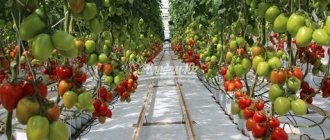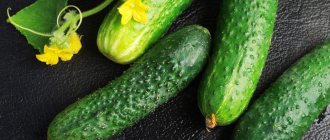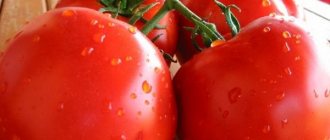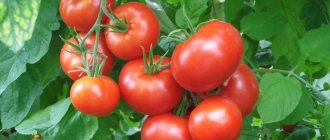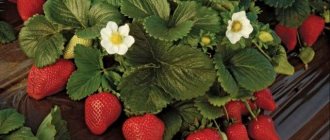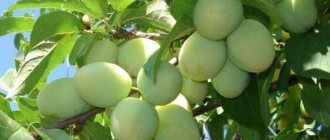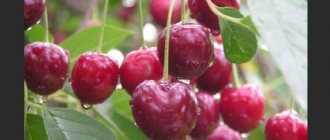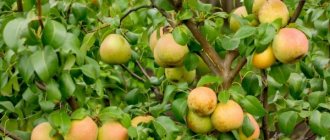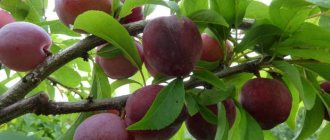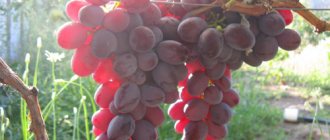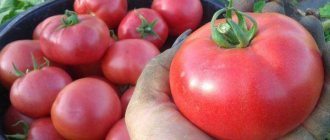The Kibria F1 cucumber is a Dutch hybrid endowed with all the properties that vegetables created in this country are famous for. It is resistant to diseases, easily tolerates a lack of light and air, thanks to which it can be cultivated in heated greenhouses even in winter, and does not require pollination. The fruits have excellent taste and aroma.
| Landing location | Ripening time | Mode of application | Fruit length | Group | Fruit smoothness | Pollination method |
| Universal | Mid-early (46-55 days) | Universal | Medium - from 10 to 15 cm | Hybrid | Highly lumpy | Parthenocarpic |
Description of the variety
Cucumber Kibria F1 is a generative, powerful and high-yielding plant. A fairly compact bush of this variety is easy to form.
Kibria grows well and bears fruit in soil rich in nutrients. Basically, the plant is grown in greenhouses, as it is a parthenocarpic (self-pollinating) variety. But it is possible to grow the crop in open ground without film covering.
Kibria is a vine-type plant, so it must be tied to a net, trellis or other support.
Due to its strong set, the variety is considered high-yielding. At the same time, strong shoots can easily withstand the load and do not shed flowers and new ovaries. Cucumber fruits are short, oval in shape. The color is dark green with small light stripes, the surface has medium-sized tubercles. Cucumbers have a characteristic crunch when bitten. The pulp is sweet, very dense, without voids.
The ratio of the length and thickness of the vegetable is 3.2:1. The fruits ripen very early. In 1 bosom they are tied from 2 to 5 pieces. The leaves are green, standard size.
Main characteristics of the hybrid
The hybrid is parthenocarpic, that is, it forms a harvest of greens without pollination, not depending on the vagaries of the weather and the presence of insects. The ovaries develop without fertilization, due to which the seeds do not ripen in the fruits (their shells do not harden).
For high-yielding “parthenocarpics” with a bouquet arrangement of ovaries, it is important how much the plant is able to withstand a large load of fruits without stopping growth or reducing the rate of yield. Hybrid "Kibria F1" is a very powerful plant, indeterminate (not limited in growth), medium or tall, highly branched. Many professionals note the generative type of plant, which makes it possible to harvest in waves not only in the recommended first rotation, but also in the second - summer-autumn.
The declared marketable yield of this hybrid is 13.6-19.3 kg/m 2; its ability to intensively produce an early harvest and the duration of fruiting are considered valuable qualities.
The secrets of the yield of the Kibria F1 hybrid in the second rotation are shared by the chief agronomist of the Dneprovsky greenhouse plant (Ukraine) in an article published in the Vegetable Growing magazine.
In hybrid cucumber plants, the main fruiting is concentrated on the central stem; the ovaries are not shed. Moreover, with regular formation of the bush and compliance with the requirements of agricultural technology during the growing season, repeated (and sometimes 3-4 times) fouling of plants with fruits is observed, so it is especially important to provide cucumbers with good nutrition with nitrogen and potassium supplements.
Zelentsy are short (gherkin type), up to 10-11 cm long with a ratio of 3.2:1 to diameter, weighing on average 70-90 g. They have an elongated oval shape and a dark green color with short whitish stripes. The surface of the so-called “Dutch shirt” is covered with medium-sized and large-sized tubercles and white loose pubescence. The taste of greens is high, and the internal structure is dense, without voids, which makes them universal in use (salad, canned).
It is recommended to collect greens daily, as the fruits are prone to some overgrowth, especially in thickness. Untimely harvesting of green plants leads to the waste of plant strength and a decrease in yield indicators by up to 20%.
Hybrid "Kibria F1" is resistant to olive spot (cladosporiosis), cucumber mosaic virus (CMV) and powdery mildew (MP), as well as the ability to quickly regenerate after adverse weather factors: hypothermia, drought.
The disadvantages usually include the high cost of seeds, the need for formation and regular feeding of plants, and their susceptibility to various rots.
We offer you an interesting video with information about quality Dutch seeds.
Irina, 32 years old, Tambov
Olga, 44 years old, Orenburg
I read very flattering reviews about Kibria cucumbers and last year I planted 10 bushes. I was very pleased with both the quantity and quality of the cucumbers. I tried to root on time, collect greens, water with warm water, and carried out root and foliar feeding every 2 weeks. The harvest made me happy! And more than once! Cucumbers without flaws are smooth and beautiful, dense and easy to keep. All the neighbors were wondering what kind of variety it was? Next season I plan to plant 40-50 bushes to grow a serious crop for sale.
Elena, 52 years old, Ekaterinburg
We grow cucumbers in a polycarbonate greenhouse; outdoor conditions do not allow it. We chose several self-pollinating hybrids: Meringue, Courage, Kibria. We form the bushes into one stem and tie them to the trellis. We feed with organic matter, preventively spray against pests and downy mildew with Quadris or Infinito. To avoid root rot, we treat the seedlings with Previkur Energy. Cucumbers bear fruit very consistently throughout the season, delighting with their beautiful appearance and excellent taste.
You can find out which Dutch cucumber hybrids for greenhouses are recommended by professional Lukhovitsy farmers from the following video:
For several years she worked as a television program editor with leading producers of ornamental plants in Ukraine. At the dacha, of all types of agricultural work, she prefers harvesting, but for this she is ready to regularly weed, pull, shed, water, tie, thin out, etc. I am convinced that the most delicious vegetables and fruits are those grown with your own hands!
Found a mistake? Select the text with the mouse and click:
In Australia, scientists have begun experiments in cloning several varieties of grapes grown in cold regions. Climate warming, which is predicted for the next 50 years, will lead to their disappearance. Australian varieties have excellent characteristics for winemaking and are not susceptible to diseases common in Europe and America.
Read also: Varieties of white carrots, calorie content, benefits and harm
One of the most convenient methods for preparing a harvest of vegetables, fruits and berries is freezing. Some believe that freezing causes the nutritional and health benefits of plant foods to be lost. As a result of the research, scientists have found that there is practically no decrease in nutritional value when frozen.
You need to collect medicinal flowers and inflorescences at the very beginning of the flowering period, when the content of nutrients in them is highest. Flowers are supposed to be picked by hand, tearing off the rough stalks. Dry the collected flowers and herbs, scattered in a thin layer, in a cool room at natural temperature without access to direct sunlight.
Tomatoes have no natural protection against late blight. If late blight attacks, any tomatoes (and potatoes too) die, no matter what is said in the description of the varieties (“variety resistant to late blight” is just a marketing ploy).
Convenient Android applications have been developed to help gardeners and gardeners. First of all, these are sowing (lunar, flower, etc.) calendars, thematic magazines, and collections of useful tips. With their help, you can choose a day favorable for planting each type of plant, determine the timing of their ripening and harvest on time.
The homeland of pepper is America, but the main breeding work on developing sweet varieties was carried out, in particular, by Ferenc Horvath (Hungary) in the 20s. XX century in Europe, mainly in the Balkans. Pepper came to Russia from Bulgaria, which is why it received its usual name - “Bulgarian”.
From varietal tomatoes you can get “your own” seeds for sowing next year (if you really like the variety). But it is useless to do this with hybrids: you will get seeds, but they will carry the hereditary material not of the plant from which they were taken, but of its numerous “ancestors”.
Both humus and compost are rightfully the basis of organic farming. Their presence in the soil significantly increases the yield and improves the taste of vegetables and fruits. They are very similar in properties and appearance, but they should not be confused. Humus is rotted manure or bird droppings. Compost is rotted organic remains of various origins (spoiled food from the kitchen, tops, weeds, thin twigs). Humus is considered a higher quality fertilizer; compost is more accessible.
Planting and care
A set of measures when growing this crop includes watering, feeding, loosening and weeding the soil, protection from pests, as well as a certain formation of the bush.
Landing
When growing cucumbers in heated greenhouses, the seeds are planted at the end of December. The sprouts are transplanted to a permanent place in the greenhouse in January, when 4-5 leaves appear on the shoot. The soil temperature during planting should be 18-20°C.
2-3 days after planting, the shoots are tied to a trellis. The plant needs constant feeding (4-5 times per season). During the period of active development of shoots and the appearance of new leaves, nitrogen compounds are usually added. During flowering and fruit set, fertilizing with phosphorus is recommended. During fruit ripening, potassium and nitrogen products are used. Cucumbers are fed exclusively with aqueous solutions of fertilizers. The method of introducing dry compounds into the soil is not used when growing this variety.
In unheated greenhouses you can also harvest good harvests. But in this case, the seedlings should be planted in April - May.
If there are supports, the plants will have enough sunlight. Fertilizers for cucumbers are applied according to the same scheme as when planting in a heated greenhouse.
Bush formation
The main ripening of fruits in this variety occurs on the main stem. Therefore, experts recommend rather non-standard formation of bushes. First, it is recommended to blind the first 4 to 7 axils on the main stem. Then all the lateral shoots and excess ovaries (if there are 3 in a node) are cut off down to the trellis.
Next, you need to throw the stem over the trellis and lower it down, pinching it after 4 - 5 leaves. Leave 1-2 side shoots of the first order on the trellis. It is also recommended to remove the mustache. With this formation, the bushes remain open to the sun or artificial light, and the fruits ripen faster.
This system becomes especially relevant during low light periods.
The recommended planting density is 2.6-3 plants per 1 m².
Features of cultivation
You can grow Kibria cucumber either by seedlings or from seeds. Although experienced gardeners advise giving preference to the first option. It is more reliable and shows better germination results.
Direct sowing
Although Kibria cucumber seeds can be sown immediately in open or protected ground, it is worth noting that this cultivation option gives worse results. The place for the beds should be well lit, without drafts or wind. It is advisable if onions, legumes or cabbage grew on the site before.
Important! Cucumbers should not be planted in the same place or after eggplants and melons.
The soil for the Kibria variety should be nutritious and light, preferably sandy loam or loam. Sand should be added to heavy soil. It is advisable to fertilize the area with organic matter a month before planting, sprinkle with ash and treat with copper sulfate.
Kibriya planting material does not need to be treated before sowing, but if the packaging does not indicate that it has been prepared in production, then it is advisable to soak it in potassium permanganate. After half an hour, rinse with water and dry. To stimulate growth, you can keep the seeds for 18 hours in Epin or Zircon, but according to breeders, this is not necessary.
Direct sowing of Kibria cucumber is carried out at the end of spring in warm soil
Planting by seedling method
Before planting the Kibria cucumber, you should take care of preparing the soil in advance and buy planting material.
Comment! It is better to purchase seeds in specialized stores; they must be made in Holland.
It is also advisable to buy ready-made soil for planting, with a predominance of peat, perlite or vermiculite; it should be loose, breathable, slightly acidic, with a pH level of 6. Otherwise, there is a need for liming. If the soil was taken from the garden, then it must be processed: poured with boiling water or a manganese solution, calcined in the oven. If necessary, feed with useful substances.
If the cucumber grows in a heated greenhouse, then the seeds begin to be sown in the last days of December, and in January the seedlings are already transplanted to a permanent place. If planting is carried out in an unheated greenhouse, then sowing is postponed until the end of April.
Sow Kibria seeds in peat pots, tablets or special cassettes. This helps prevent damage to the plant’s root system during further replanting. Place no more than two seeds in each container. They are immersed to a depth of 1 cm, then sprinkled with earth and carefully watered. Before the emergence of seedlings, the temperature in the room where the Kibria seedlings stand is provided at +30 °C; when sprouts appear on the surface of the soil, the temperature is reduced to + 22 °C. At the same time as ensuring optimal temperature conditions, you should take care of lighting. The room should be light for 15-18 hours every day.
Attention! To speed up the germination of Kibria cucumber seeds, you can use a film cover.
After about half a month, when 3-4 true leaves grow on the stem, the seedlings are planted. Three seedlings are placed per square meter. Planting is carried out in shallow holes; the sprouts are not removed from the cassettes.
Sowing
Agricultural experts recommend planting kibria using the seedling method. This has a beneficial effect on the survival rate of shoots and has a positive effect on the amount of harvest.
The seeds do not require preliminary preparation; they have undergone the entire complex of processing and can be planted. It is preferable to sow seeds in special seedling cassettes or pots. This will further eliminate injuries when transplanting sprouts into a greenhouse or garden bed.
Before transplanting the seedlings, it is recommended to feed the shoots with solutions based on micro- and macroelements.
Before the appearance of 1 leaf, air humidity should not be less than 90-95%, and after it grows - 80-85%.
Watering
It is recommended to water cucumbers with water at a temperature of 20-21°C. Watering must be done when the top layer of soil dries.
Drip irrigation is considered the best option for greenhouse cucumbers, but you can also water it manually. When watering by hand, it is necessary to protect the beds from the formation of a soil crust and loosen the soil shallowly and carefully.
Before the formation of buds, cucumbers are recommended to have daily irrigation at the rate of 5-10 liters per 1 m².
Pests and diseases
Cybria cucumber rarely gets sick, but it can be affected by root rot due to stagnation of water under the plant. The disease can be prevented by simply tying up the shoots, because the less contact with the ground, the lower the likelihood of rot.
Kirbia cucumber can also be affected by pests such as aphids, whiteflies, spider mites and thrips. Aphids are eliminated with contact insecticides, and thrips - with systemic action. It is difficult to remove whiteflies; it is better to prevent this pest - to prevent an increase in temperature and humidity. Specialized drugs - acaricides - will get rid of spider mites.
Advantages and disadvantages of the variety
Cucumber Kibria F1 has many advantages over other varieties of this vegetable crop:
- cucumbers are not demanding to care for;
- resistant to adverse weather conditions;
- their fruits do not taste bitter;
- Kibria has excellent taste;
- the variety is resistant to most diseases;
- Cucumbers have a long shelf life.
Disadvantages of a hybrid:
- low resistance to root rot;
- need for feeding;
- expensive seeds.
In conclusion, we can say that the Kibria cucumber has extremely high yields and does not require special care. It can be used both fresh and for preservation. Properly selected soil, periodic fertilizing and timely watering will further increase the yield of the variety.
A successful experiment by Dutch scientists
This hybrid was bred by the Dutch working for the company Rijk Zwaan. The experiment was truly successful - Kibria cucumbers turned out to be early ripening, relatively unpretentious, and with excellent taste. Nine years have passed, this hybrid has become popular all over the world, and in Russia it was included in the State Register of Breeding Achievements in 2011.
Kibria cucumbers grow well in the North-Western region and Central Russia. Particularly experienced gardeners grow Kibria year-round in greenhouse conditions, leaving good reviews about the yield and taste. The plant feels great in a film greenhouse, but it is not recommended to plant it in an open bed (we will tell you why later).
